Vögel zu suchen in Engdain neben dem festival da jazz
Klasse aves (Vögel / Birds):
Ordnung Passeriformes (Singvögel / Passerine):
Unterordnung Passeri (Sperlingsvögel):
Überfamilie Sylvioidea:
Familie Sylviidae (Grasmücken / Old world warblers):
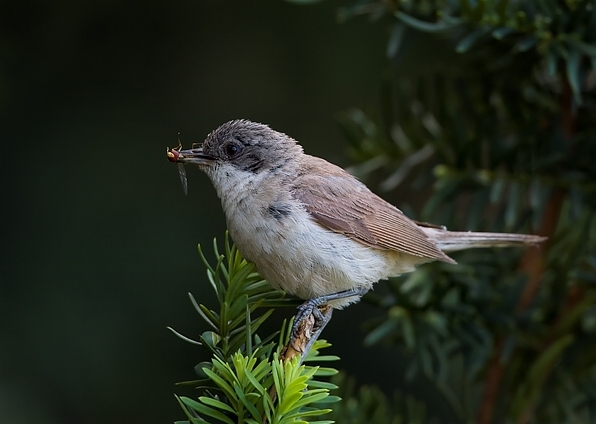
Wikipedia: Lesser whitethroat
Had hoped to hear and see it in Toggenburg but I didn't; said to be possible in Engadin.
Gesang: ![]() Klappernd. (Müllerchen) An Berglaubsänger erinnernd. Klappertöne (5-8) Aber oft mit leisem schwatzendem Vorgesang, der fehlen kann. Kann auch an Sumpfmeise erinnern, doch sind bei dieser die Klappertöne mehr von oben her angeschlagen.
[Link]
Klappernd. (Müllerchen) An Berglaubsänger erinnernd. Klappertöne (5-8) Aber oft mit leisem schwatzendem Vorgesang, der fehlen kann. Kann auch an Sumpfmeise erinnern, doch sind bei dieser die Klappertöne mehr von oben her angeschlagen.
[Link]
![]() Song typically consists of two parts. An indistinct chattering and warbling, subsong-like part similar to Whitethroat, which is usually followed by a dry, fast and rattling trill. The trill carries much further than the chattering part. May be difficult to identify if trill is omitted. [Link]
Song typically consists of two parts. An indistinct chattering and warbling, subsong-like part similar to Whitethroat, which is usually followed by a dry, fast and rattling trill. The trill carries much further than the chattering part. May be difficult to identify if trill is omitted. [Link]
Rufe: ![]() „tze“ oder „tett“
[Link]
„tze“ oder „tett“
[Link]
![]() Warning call a hard "check" similar to Blackcap but slightly softer. [Link]
Warning call a hard "check" similar to Blackcap but slightly softer. [Link]
Körperlich: Länge=12-13 cm,
Flügelspanne=16-20 cm,
Gewicht=10-14 g
Gesang:
![]() Song typically consists of two parts. An indistinct chattering and warbling, subsong-like part similar to [common] Whitethroat, which is usually followed by a dry, fast and rattling trill. The trill carries much further than the chattering part. May be difficult to identify if trill is omitted. [Link]
Song typically consists of two parts. An indistinct chattering and warbling, subsong-like part similar to [common] Whitethroat, which is usually followed by a dry, fast and rattling trill. The trill carries much further than the chattering part. May be difficult to identify if trill is omitted. [Link]
Gesang Eigenschaften:
Melody: einfach rhythmisch, langsam, Frequency: 3-5 KHz Special sounds: Triller
Ruf:
BirdID says: Warning call a hard "check" similar to Blackcap but slightly softer
♫ (Ruf)
Ruf Eigenschaften:
Ruf Melodie: einnotig, langsam, Frequenz: 2-7 KHz, Spezielle Klänge: stottern/kieseln
Familie Hirundinidae (Schwalben / Swallows):

Wikipedia: Eurasian crag-martin Europa
Deutschland: Brut-, Zugvogel RL R
Vokalisierung: ![]() Most heard is a House Martin-like, but less rolling, "prit" or "check". Other contact sounds include a plaintive "peeuuu". [Link]
Most heard is a House Martin-like, but less rolling, "prit" or "check". Other contact sounds include a plaintive "peeuuu". [Link]
Gesang: ![]() Song an inconspicuous, staccato series of twittering notes, with a wagtail-like timbre. [Link]
Song an inconspicuous, staccato series of twittering notes, with a wagtail-like timbre. [Link]
Körperlich: Länge=14 cm,
Flügelspanne=32-34 cm,
Gewicht=17-30 g
Familie Alaudidae (Lerchen / Larks):
Profil Wikipedia eBird Vogelwarte BirdLife ZH Audubon AllAboutBirds Xeno-Canto BirdID NABU
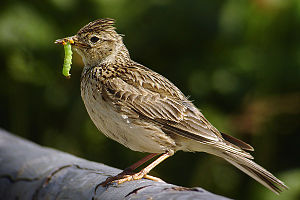
Wikipedia Eurasian Skylark (Alauda arvensis). Quelle: WIKIPEDIA
Dieser Vogel erscheint jenseits grossen Meere in Kontinenten :
Europa, Nordamerika (introduced), Afrika.
Geographie: ![]() Introduced population in North America is gradually declining. [Link]
Introduced population in North America is gradually declining. [Link]
Stark gefährdet durch Verlust von geeignetem Lebensraum. Eine Massnahme ist die Erstellung von Lerchenfenstern auf den Feldern - eine kleine Fläche mitten im Feld, die nicht bepflanzt oder gemäht wird. So was sieht man bei uns, z.B. zwischen Freudwil und Gutenswil, wobei ich nicht genau weiss, ob Feldlerchen das Ziel davon sind. Die Infos habe ich vom FOK Kurs 2021-2022 von Christina Ebneter.
Gesang: ![]() Song a pleasing energetic stream of chirping, merry trills, interspersed with mimicry. Trills quite resonant with fairly full tone. Song usually given in flight high in the air. Less characteristic, shorter, weaker and more varied song when given from ground. [Link]
Song a pleasing energetic stream of chirping, merry trills, interspersed with mimicry. Trills quite resonant with fairly full tone. Song usually given in flight high in the air. Less characteristic, shorter, weaker and more varied song when given from ground. [Link]
Rufe: ![]() Most typical flight call a short trilling "chirrup", with the end note noticeably lower pitched than the start. Also several other more cryptic calls. [Link]
Most typical flight call a short trilling "chirrup", with the end note noticeably lower pitched than the start. Also several other more cryptic calls. [Link]
Körperlich: Länge=18-19 cm,
Flügelspanne=30-36 cm,
Gewicht=26-50 g
Überfamilie Passeroidea:
Familie Passeridae (Sperlinge / Sparrows):

Wikipedia: Alpine accentor
Deutschland: Brut-, Jahres-, Zugvogel RL R
Gesang: ![]() Song is a varied stream of melodious and chattering notes, more resembling skylark than the much higher pitched Dunnock. [Link]
Song is a varied stream of melodious and chattering notes, more resembling skylark than the much higher pitched Dunnock. [Link]
Rufe: ![]() Most common call a noisy "tchrt", often repeated in short, retarding series. Also has a more pleasant, ringing Snow Bunting-like "prrrriitt". [Link]
Most common call a noisy "tchrt", often repeated in short, retarding series. Also has a more pleasant, ringing Snow Bunting-like "prrrriitt". [Link]
Körperlich: Länge=18 cm,
Flügelspanne=30-32 cm,
Gewicht=37-43 g
Profil Wikipedia eBird Vogelwarte BirdLife ZH Xeno-Canto BirdID NABU
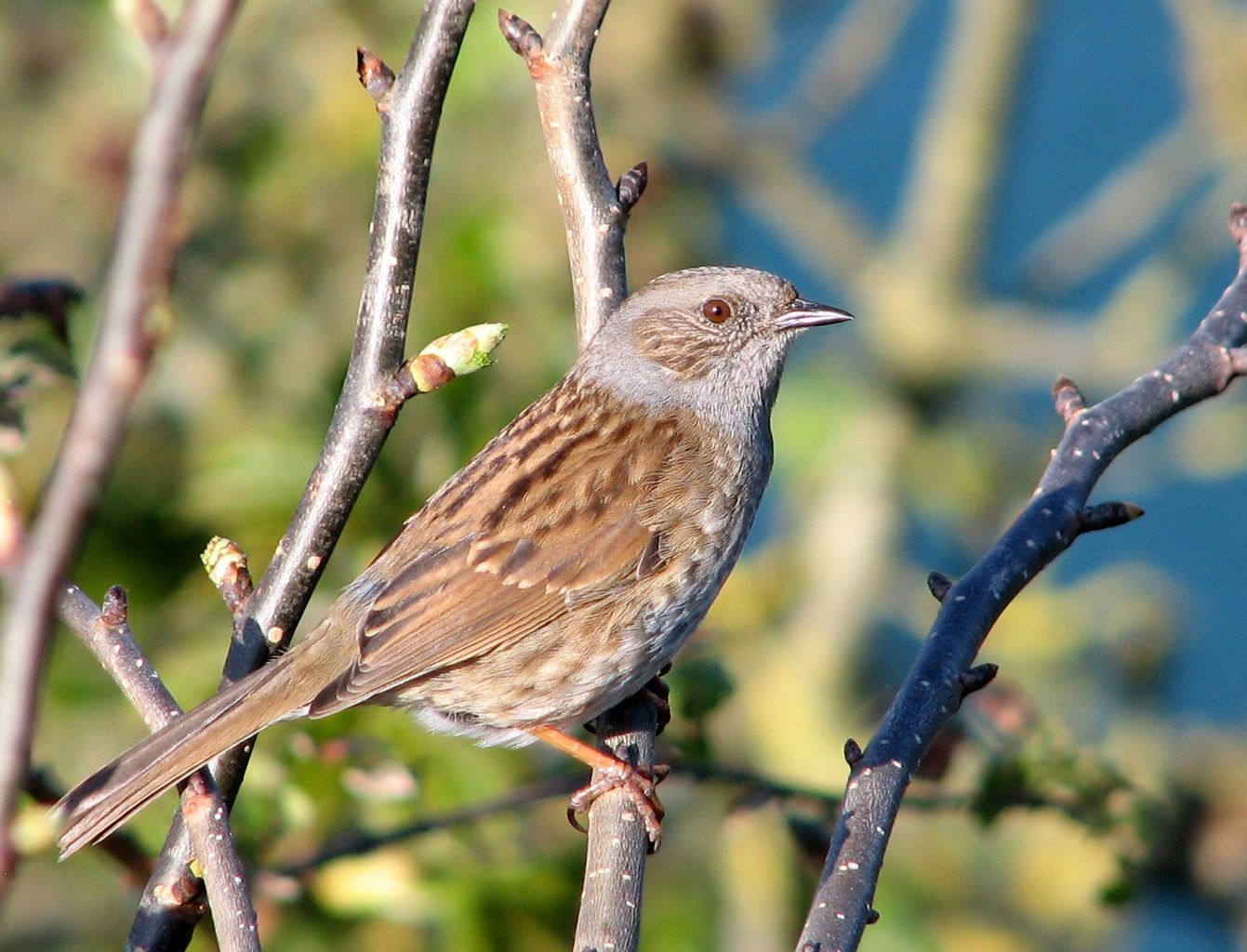
Wikpedia photo because never seen. Quelle: WIKIPEDIA
Heard at Hungerseeli and near Lendikon but not yet seen. They hide well!
Gesang: ![]() Singt schon im Vorfrühling. Klangfarbe ähnlich Gartenbaumläufer. Aufbau ähnlich Zaunkönig, aber ohne Triller. Viel leiser und dünner.
[Link]
Singt schon im Vorfrühling. Klangfarbe ähnlich Gartenbaumläufer. Aufbau ähnlich Zaunkönig, aber ohne Triller. Viel leiser und dünner.
[Link]
![]() Song a fast and evenly paced, high pitched stream of clear notes. No consistent phrasing. Similar in timbre to Robin, but does not vary tempo or pitch nearly as much. Often compared to the sound of a squeaky wheelbarrow. [Link]
Song a fast and evenly paced, high pitched stream of clear notes. No consistent phrasing. Similar in timbre to Robin, but does not vary tempo or pitch nearly as much. Often compared to the sound of a squeaky wheelbarrow. [Link]
Rufe: ![]() Hohe „zi“ „tsi“. Auf dem Zug „zieht“. Etwas absinkend..
[Link]
Hohe „zi“ „tsi“. Auf dem Zug „zieht“. Etwas absinkend..
[Link]
![]() Contact call a dry, thick trill "trrr", and a short King Fisher-like, high-pitched "zeep". [Link]
Contact call a dry, thick trill "trrr", and a short King Fisher-like, high-pitched "zeep". [Link]
Körperlich: Länge=14 cm,
Flügelspanne=19-21 cm,
Gewicht=16-25 g
Gesang:
High-pitched, repetitive but complex little tune.
Gesang Eigenschaften:
Melody: stereotypisch melodisch, schnell, Frequency: high (3-9 KHz) Singing season: 02-15 - 07-31 Dawn chorus start, 45 minutes before dawn.
Ruf:
Swooping staccato call 0.5 seconds long heard near Lendikon. Repeated irregularly after 1-3.5 seconds.
♫ Quelle: XENOCANTO (Ruf)
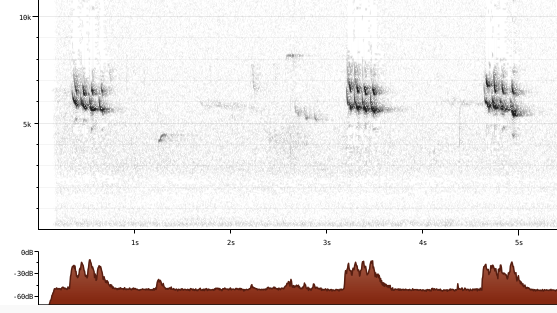
Ruf Eigenschaften:
Ruf Melodie: einnotig, schnell, Frequenz: 5-7 KHz, Spezielle Klänge: absteigend
Familie Fringillidae (Finken):
Profil Wikipedia eBird Xeno-Canto NABU

Wikipedia: Common redpoll - Wikipedia
Deutschland: Zugvogel, Wintergast

Wikimedia Red Crossbills (Male). Quelle: WIKIPEDIA
Dieser Vogel erscheint jenseits grossen Meere in Kontinenten :
Europa, Nordamerika, Afrika.
Fichten- und Tannenwälder. Manche verbringen den Winter in der Schweiz, andere sind ganzjährig hier.
Aussehen und Identifizierung: ![]() Nabu.de: das Männchen schon von weitem durch seine ziegelrote Farbe auf. Das Weibchen dagegen ist unscheinbar graugrün gefärbt.Größe: 15 bis 17 Zentimeter
Zugtyp: Teilzieher
Beobachtungszeitraum: Oktober bis April, im Mittelgebirge und Alpenraum ganzjährig. [Link]
Nabu.de: das Männchen schon von weitem durch seine ziegelrote Farbe auf. Das Weibchen dagegen ist unscheinbar graugrün gefärbt.Größe: 15 bis 17 Zentimeter
Zugtyp: Teilzieher
Beobachtungszeitraum: Oktober bis April, im Mittelgebirge und Alpenraum ganzjährig. [Link]
![]() New research suggests that there may be as many as eight different full species of Red Crossbills on [North America]. [Link]
New research suggests that there may be as many as eight different full species of Red Crossbills on [North America]. [Link]
Verhalten: ![]() Wikipedia: Eine Vogelart aus der Familie der Finken (Fringillidae).Das klassische Habitat stellen insbesondere während der Brutzeit Nadelwaldgebiete bis zur Baumgrenze in den Alpen dar. [Link]
Wikipedia: Eine Vogelart aus der Familie der Finken (Fringillidae).Das klassische Habitat stellen insbesondere während der Brutzeit Nadelwaldgebiete bis zur Baumgrenze in den Alpen dar. [Link]
Gesang: ![]() The song consist of improvised, resonant twittering, and series of contact calls with no apparent phrases. It is generally faster, with less marked pauses than in Parrot Crossbill, and the phrasing seems more random. [Link]
The song consist of improvised, resonant twittering, and series of contact calls with no apparent phrases. It is generally faster, with less marked pauses than in Parrot Crossbill, and the phrasing seems more random. [Link]
Rufe: ![]() Contact call similar to Parroy Crossbill's "tupp", but is on average higher and less powerful, with a "cut-off" ending. In sum: Parrot Crossbill; hard attack, soft ending, Crossbill: softer attack, cut-off ending. Beware regional variations and overlap in pitch of calls with Parrot. [Link]
Contact call similar to Parroy Crossbill's "tupp", but is on average higher and less powerful, with a "cut-off" ending. In sum: Parrot Crossbill; hard attack, soft ending, Crossbill: softer attack, cut-off ending. Beware regional variations and overlap in pitch of calls with Parrot. [Link]
Körperlich: Länge=16 cm,
Flügelspanne=27-30 cm,
Gewicht=35-50 g
Gesang:
Repeated hi-low pattern...well, doesn't always sound like that.
The very short beginning of my Stazersee recording before the static sets in does,
as well as a song found online.
One recording reminds me of cicada sounds.
Gesang Eigenschaften:
Melody: stereotypisch melodisch, langsam, Frequency: 2-10 KHz
Profil Wikipedia eBird Vogelwarte BirdLife ZH Xeno-Canto BirdID NABU
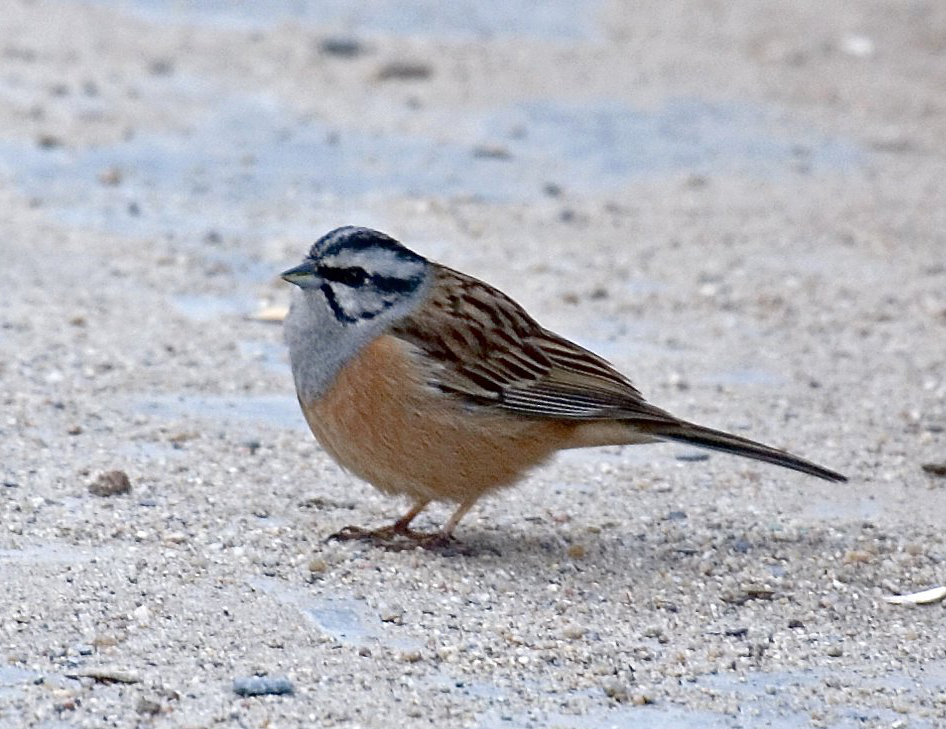
Wikipedia: Rock bunting
Deutschland: Brut-, Jahres-, Zugvogel RL 1
Gesang: ![]() Song variable, but usually distinct. [Link]
Song variable, but usually distinct. [Link]
Rufe: ![]() Recalls stuttering Dunnock. Jerky, uneven thythm and tempo, with fairly large register and recognizible bunting timbre. May include mimicry. Alarm call a thin, short "seeeep", with clipped ending, similar to Cirl Bunting. [Link]
Recalls stuttering Dunnock. Jerky, uneven thythm and tempo, with fairly large register and recognizible bunting timbre. May include mimicry. Alarm call a thin, short "seeeep", with clipped ending, similar to Cirl Bunting. [Link]
Körperlich: Länge=16 cm,
Flügelspanne=21-27 cm,
Gewicht=21-29 g
Familie Motacillidae (Stelzenverwandte):
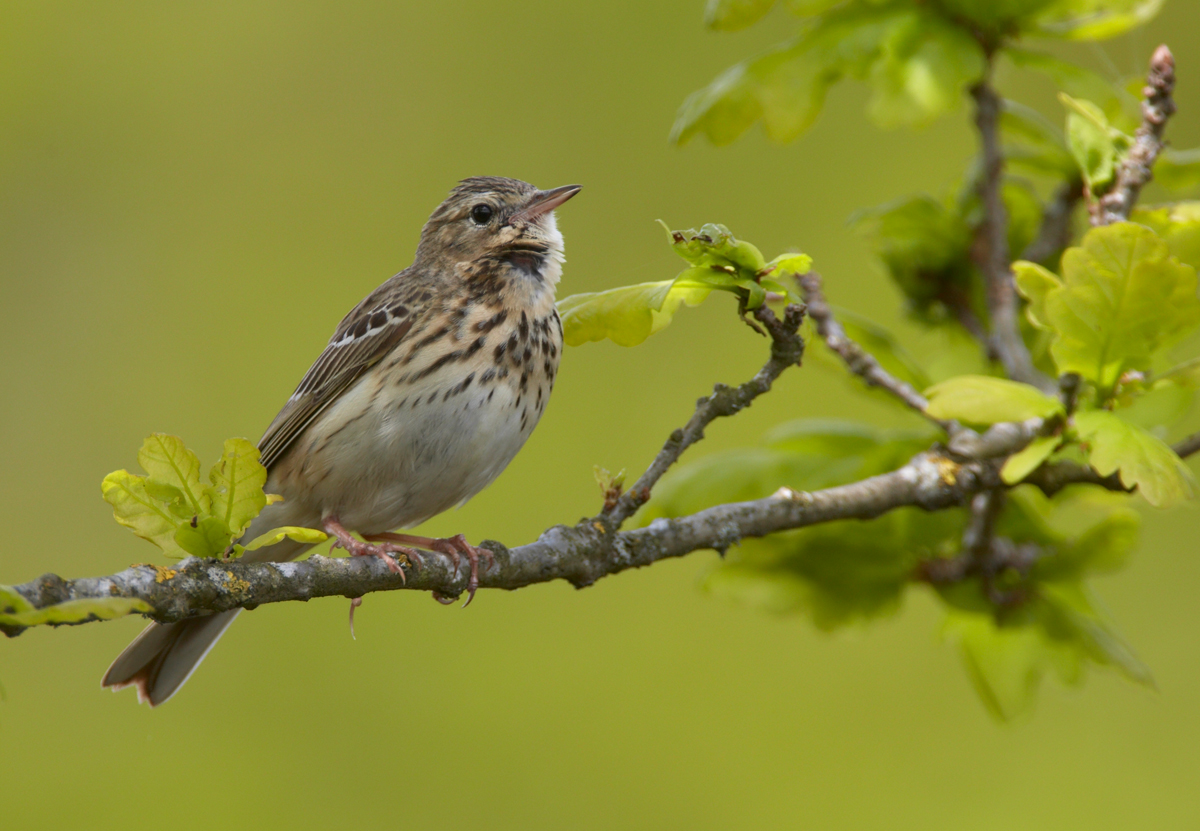
Wikipedia baumpieper Anthus trivialis. Von Vogelartinfo - Eigenes Werk, GFDL 1.2, Link Quelle: WIKIPEDIA
Allgemein: ![]() Der Baumpieper (Anthus trivialis) ist eine Vogelart aus der Familie der Stelzen und Pieper (Motacillidae). Der im Sommer in Mitteleuropa häufige, aber optisch unauffällige Vogel ist vor allem an Waldrändern und -lichtungen zu beobachten, da er neben einem Bestand an hohen Bäumen und Sträuchern auch offene, mit niedriger Vegetation bestandene Flächen benötigt. Er fällt dort vor allem durch seinen Gesang auf.
[more]
Der Baumpieper (Anthus trivialis) ist eine Vogelart aus der Familie der Stelzen und Pieper (Motacillidae). Der im Sommer in Mitteleuropa häufige, aber optisch unauffällige Vogel ist vor allem an Waldrändern und -lichtungen zu beobachten, da er neben einem Bestand an hohen Bäumen und Sträuchern auch offene, mit niedriger Vegetation bestandene Flächen benötigt. Er fällt dort vor allem durch seinen Gesang auf.
[more]
Gesang: ![]() Mehrere unterschiedliche Tonreihen aneinandergefügt. Zuletzt „zia zia zia ziah“. Zuerst auf Baum sitzend, dann im Singflug, Zia-Rufe während Gleitflug (Fallschirmvogel) [Link]
Mehrere unterschiedliche Tonreihen aneinandergefügt. Zuletzt „zia zia zia ziah“. Zuerst auf Baum sitzend, dann im Singflug, Zia-Rufe während Gleitflug (Fallschirmvogel) [Link]
![]() Song characteristic. Starts with a series of Chaffinch-like "che-che-che" which gives way to long, descending, "ricocheting" whistling notes (especially at the end of song-flight). [Link]
Song characteristic. Starts with a series of Chaffinch-like "che-che-che" which gives way to long, descending, "ricocheting" whistling notes (especially at the end of song-flight). [Link]
Rufe: ![]() “psiet“ etwas nach unten gezogen. Auch „zieh“
[Link]
“psiet“ etwas nach unten gezogen. Auch „zieh“
[Link]
![]() Flight call a short buzzing "tzzzeet". Given at even pitch, and in a fuller tone than Red-Throated Pipit. [Link]
Flight call a short buzzing "tzzzeet". Given at even pitch, and in a fuller tone than Red-Throated Pipit. [Link]
Körperlich: Länge=15 cm,
Flügelspanne=25-27 cm,
Gewicht=18-29 g
Profil Wikipedia eBird Vogelwarte BirdLife ZH Xeno-Canto BirdID NABU
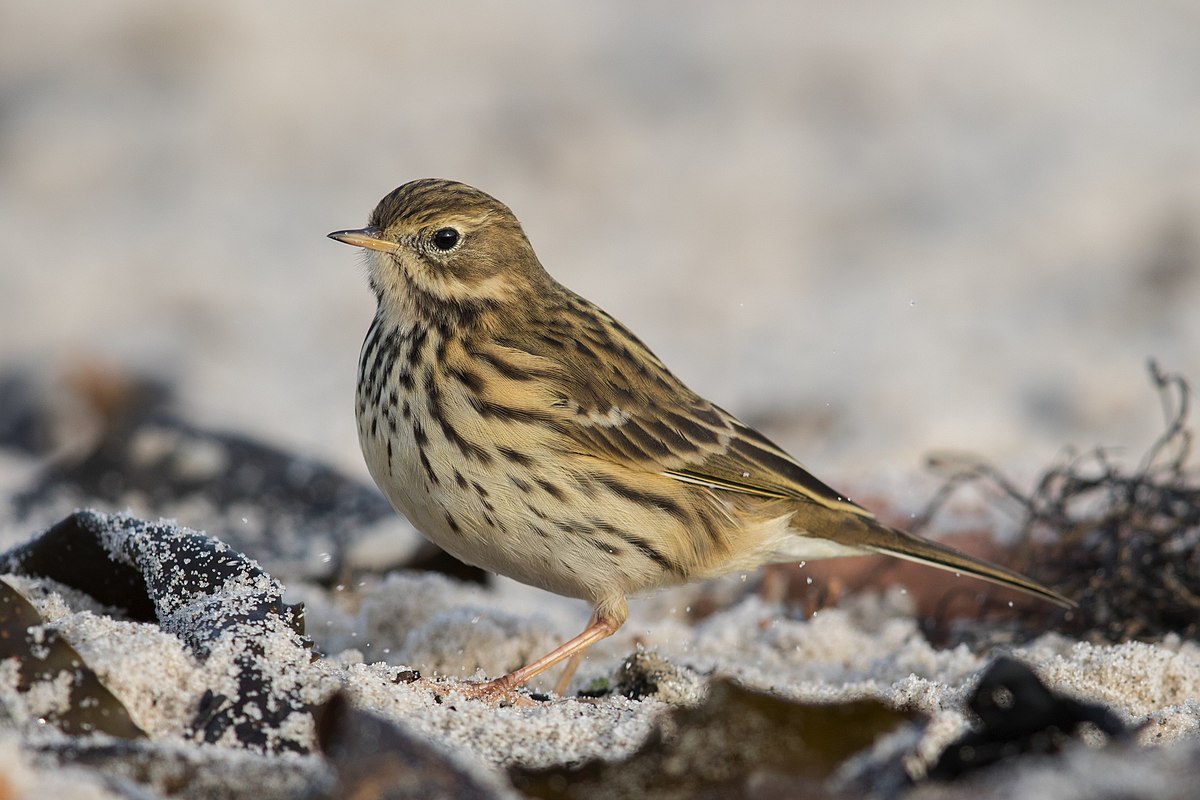
Wikipedia: Meadow pipit
Deutschland: Brut, Zugvogel, Wintergast RL V
Gesang: ![]() Song very similar to Rock Pipit, but tone less full and more brittle. Lacks Rock Pipit's closing trill, and beginning is less "hammering". [Link]
Song very similar to Rock Pipit, but tone less full and more brittle. Lacks Rock Pipit's closing trill, and beginning is less "hammering". [Link]
Rufe: ![]() Contact call a short "eest". Similar to Rock Pipit but shorter,cleaner and most often in quick series. Warning call a sharp, high pitched "tzeet". Also a rattling "trrrrt". [Link]
Contact call a short "eest". Similar to Rock Pipit but shorter,cleaner and most often in quick series. Warning call a sharp, high pitched "tzeet". Also a rattling "trrrrt". [Link]
Körperlich: Länge=14 cm,
Flügelspanne=22-25 cm,
Gewicht=15-22 g
Familie Paridae (Meisen / Titmice):
Gattung Parus:
Weidenmeise / Willow tit (Parus montanus)
Profil Wikipedia eBird Vogelwarte BirdLife ZH Xeno-Canto NABU
Willow tit. 2020-04-25 08.51.40 Luppmen
Allgemein: ![]() Die Weidenmeise oder Mönchsmeise (Poecile montanus, Syn.: Parus montanus, zu lateinisch montanus ‚bergzugehörig‘), auch Mattköpfige Sumpfmeise, ist eine Vogelart in der Familie der Meisen (Paridae). In Mitteleuropa ist diese Meisenart ein weit verbreiteter und zum Teil sehr häufiger Brut- und Jahresvogel.
[more]
Die Weidenmeise oder Mönchsmeise (Poecile montanus, Syn.: Parus montanus, zu lateinisch montanus ‚bergzugehörig‘), auch Mattköpfige Sumpfmeise, ist eine Vogelart in der Familie der Meisen (Paridae). In Mitteleuropa ist diese Meisenart ein weit verbreiteter und zum Teil sehr häufiger Brut- und Jahresvogel.
[more]
Gattung Lophophanes:
Haubenmeise / European crested tit (Lophophanes cristatus)
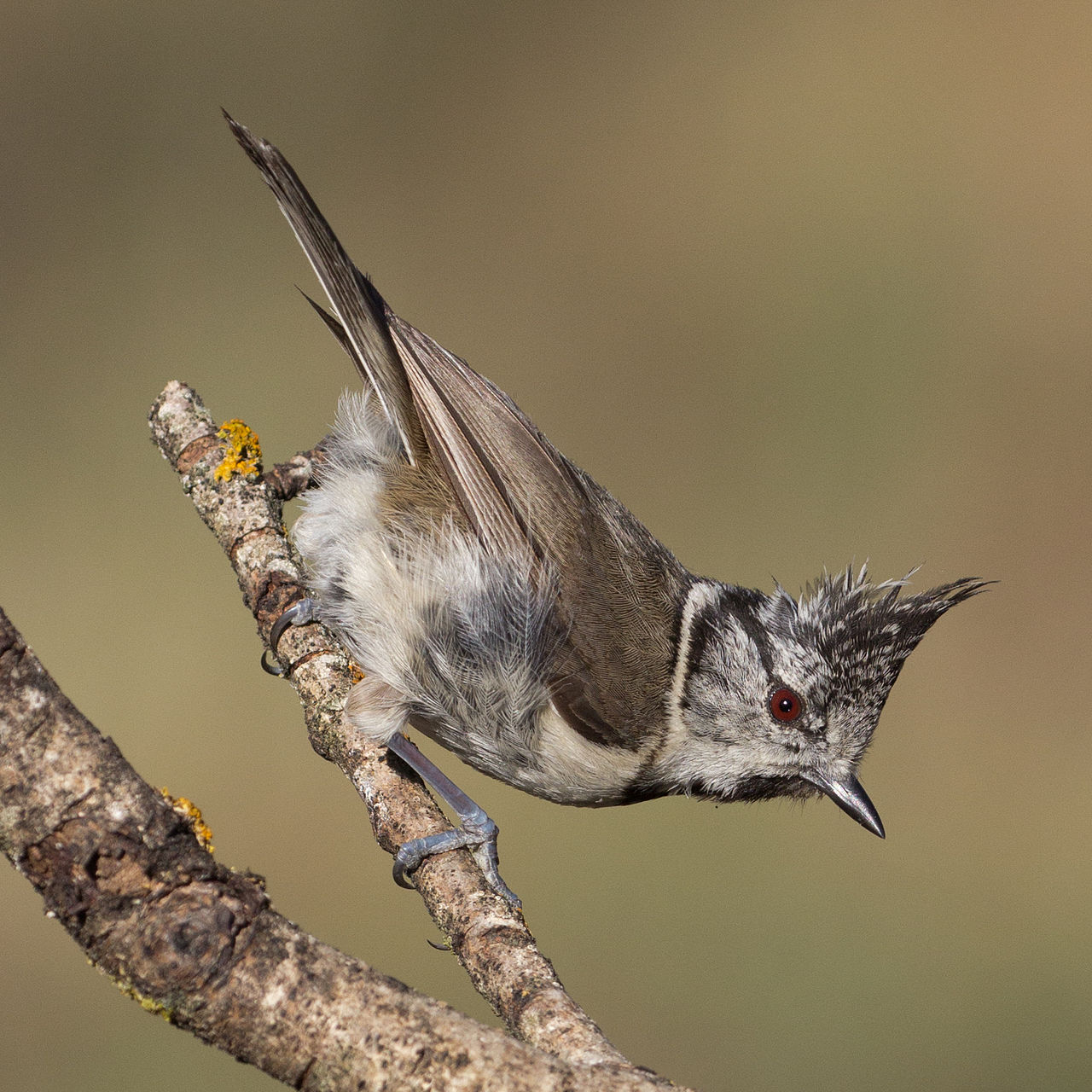
Wikipedia - Haubenmeise - Lophophanes cristatus - 01 - Carlos Delgado. Quelle: WIKIPEDIA
![]() Die Haubenmeise (Lophophanes cristatus, Syn.: Parus cristatus; zu lateinisch crista ‚Kamm‘) ist eine Vogelart in der Familie der Meisen (Paridae). Diese Singvögel sind in Mitteleuropa ein weit verbreiteter und häufiger Brut- und Jahresvogel.
[more]
Die Haubenmeise (Lophophanes cristatus, Syn.: Parus cristatus; zu lateinisch crista ‚Kamm‘) ist eine Vogelart in der Familie der Meisen (Paridae). Diese Singvögel sind in Mitteleuropa ein weit verbreiteter und häufiger Brut- und Jahresvogel.
[more]
Gesehen nah bei Pragelpasshöhe, zusammen mit Tannenmeisen, Haubenmeisen und Sommergoldhähnchen
Gesang: ![]() Song: an improvisation over previously described calls. [Link]
Song: an improvisation over previously described calls. [Link]
Rufe: ![]() Call a characteristic vibrating rolling trill "Trrrrurrrurrrit", with last syllable emphasized and ending with ascending pitch. Often preceded by a couple of introductory "tzi tzi". [Link]
Call a characteristic vibrating rolling trill "Trrrrurrrurrrit", with last syllable emphasized and ending with ascending pitch. Often preceded by a couple of introductory "tzi tzi". [Link]
Körperlich: Länge=11 cm,
Flügelspanne=17-20 cm,
Gewicht=10-13 g
Gesang:
Higher-pitched than great tit - how distinguish from coal tit, etc?
Gesang Eigenschaften:
Melody: einfach rhythmisch, schnell, Frequency: high (3-9 KHz) Special sounds: lallen
Gattung Poecile:
Weidenmeise / Willow tit (Poecile montanus)
Willow tit. 2020-04-25 08.51.40 Luppmen
Vogelwarte.ch says, Two forms of Poecile montanus exist in Switzerland: the Willow Tit occurs in the Jura, the Pre-Alps and locally on the Central Plateau, while the Alpine Tit is confined to the Alps. The two forms have a distinct song as well as different ecological requirements, and could evolve into two species over time.
Since I've heard them in St. Moritz, they're more properly alpine tits than willow tits.
I should verify the audio recordings vs xenocanto, etc, as it was BirdNet that identified
them as willow tits, and it is not infallible.
Vokalisierung: ![]() Other sounds: high pitced "zi zi" similar to other tits. [Link]
Other sounds: high pitced "zi zi" similar to other tits. [Link]
Gesang: ![]() 1.Gesangstyp: „ziü ziü ziü „ etwas wehmütig, die einzelnen Töne leicht absinkend, nicht klappernd. Bei Unterart Alpenmeise auf gleicher Höhe bleibend. 2.Gesangstyp: variable, schwätzende, helle Folge m. trillerndem Schluss. [Link]
1.Gesangstyp: „ziü ziü ziü „ etwas wehmütig, die einzelnen Töne leicht absinkend, nicht klappernd. Bei Unterart Alpenmeise auf gleicher Höhe bleibend. 2.Gesangstyp: variable, schwätzende, helle Folge m. trillerndem Schluss. [Link]
![]() Song: One or two soft, clear, melancholic notes repeated in a slow, even rhythm. At first rising slightly in pitch, then gradually falling. In some areas song is evenly pitched. [Link]
Song: One or two soft, clear, melancholic notes repeated in a slow, even rhythm. At first rising slightly in pitch, then gradually falling. In some areas song is evenly pitched. [Link]
Rufe: ![]() Folge v. etwas heiser näselnden „zi zi dääh dääh. (einmalige Laute)
[Link]
Folge v. etwas heiser näselnden „zi zi dääh dääh. (einmalige Laute)
[Link]
![]() Call: Most characteristic call a frequently uttered, nasal "ti ti chaa chaa chaa". First notes high pitched and the following lower, coarse, nasal and drawn. Sometimes uttered without the introductory high pitched notes. [Link]
Call: Most characteristic call a frequently uttered, nasal "ti ti chaa chaa chaa". First notes high pitched and the following lower, coarse, nasal and drawn. Sometimes uttered without the introductory high pitched notes. [Link]
Körperlich: Länge=11 cm,
Flügelspanne=17-20 cm,
Gewicht=8-14 g
Gesang:
Songs I've heard alternate two notes and look like a sine wave on the sonogram.
Vogelwarte.ch: Apart from minor differences in diet and size, Alpine Tit and Willow Tit can only be identified by their song. The Willow Tit utters a series of long, descending notes («tyoo tyoo tyoo tyoo»), whereas the Alpine Tit’s territorial song consists of short notes on an even pitch («dee dee dee dee dee»).
See more here.
Gesang Eigenschaften:
Melody: einfach rhythmisch, langsam, Frequency: 3-7 KHz
Familie Turdidae (Drosseln / Thrushes):
Gattung Turdus:
Ringdrossel / Ring ouzel (Turdus torquatus)
Profil Wikipedia eBird Vogelwarte BirdLife ZH Xeno-Canto BirdID NABU
Ringdrossel bei der Bergstation, Gamsalp. 2021-06-27 03.25.30 Wildhaus
Deutschland: Brut-, Zugvogel
Gesang: ![]() Song a primitive, plaintive series of short phrases. Often with only one or two syllables. Interspersed with eerie, higher pitched sounds, reminiscent of Song Thrush. [Link]
Song a primitive, plaintive series of short phrases. Often with only one or two syllables. Interspersed with eerie, higher pitched sounds, reminiscent of Song Thrush. [Link]
Rufe: ![]() Alarm call a series of "chok-chok". Thicker and more resonant than Redwing. [Link]
Alarm call a series of "chok-chok". Thicker and more resonant than Redwing. [Link]
Körperlich: Länge=23-24 cm,
Flügelspanne=38-42 cm,
Gewicht=92-138 g
Familie Muscicapidae (Schnäpperverwandte / Old world flycatchers):
Gattung Saxicola:
Braunkehlchen / Whinchat (Saxicola rubetra)
Profil Wikipedia eBird Vogelwarte BirdLife ZH Xeno-Canto BirdID NABU
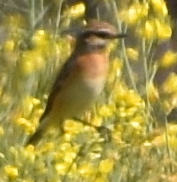
Mysterium im Rapsfeld von Friedliweid 2020-04-27 11.29.08 Luppmen
Die bauen ein Nest auf dem Boden auf einer Wiese oder Feld und brauchen relativ lang bis die Jungen flugge sind,
darum hoffe ich, dass sie weitergezogen sind. Da Felder selten so lang ungestört bleiben im Mittelland,
sind sie immer mehr in höheren Lagen zu finden.
Diesen Vogel haben wir paarweise in einem Rapsfeld entdeckt.
Von weitem konnte man nur etwas orange Farbe entdecken.
Ich habe ihn 2 Tage später im gleichen Feld gesucht und bin um das ganze Feld gelaufen.
Erst am Ende habe ich ihn gesehen: am Anfang, sicher 100m von mit entfernt und um 2 Ecken.
Da habe ich dieses Foto gemacht und in Büchern, Apps und Internet nach seiner Identität gesucht.
Als ich ein sehr ähnliches Bild auf ornitho.ch gefunden habe, wo er auch auf einer Rapspflanze drauf sitzt,
sah ich es als bestätigt, dass es ein Braunkelchen war.
Vokalisierung: ![]() The "peeu"-sound is depper and more resonant than similar sounds by Wheatear and Stonechat. [Link]
The "peeu"-sound is depper and more resonant than similar sounds by Wheatear and Stonechat. [Link]
Der Gesang (bei Vogelwarte.ch) klingt für mich ähnlich wie eine Mönchsgrasmücke, aber nur in sehr kurzen Phrasen
Gesang: ![]() Kurzes (3-7 Töne) Liedchen mit 1-2 Kreischlauten, (ähnlich der Mittellaute b. Hausrotschwanz) variabel. Ahmt auch andere Vögel nach.
[Link]
Kurzes (3-7 Töne) Liedchen mit 1-2 Kreischlauten, (ähnlich der Mittellaute b. Hausrotschwanz) variabel. Ahmt auch andere Vögel nach.
[Link]
![]() Song variable with lots of mimicry. The short phrases starts with dry, rattling or sneering trills, followed by clear whistling notes and expert mimicry. More varied, both in tone and tempo, than both Stonechat and Wheatear. [Link]
Song variable with lots of mimicry. The short phrases starts with dry, rattling or sneering trills, followed by clear whistling notes and expert mimicry. More varied, both in tone and tempo, than both Stonechat and Wheatear. [Link]
Rufe: ![]() „teck, teck“ (ähnlich wie wenn man zwei Steine zusammen schlägt)
[Link]
„teck, teck“ (ähnlich wie wenn man zwei Steine zusammen schlägt)
[Link]
![]() Contact call resembles many of it relatives. A short, soft "peeu", followed by a hard "check" (like hitting two rocks together). [Link]
Contact call resembles many of it relatives. A short, soft "peeu", followed by a hard "check" (like hitting two rocks together). [Link]
Körperlich: Länge=12 cm,
Flügelspanne=21-24 cm,
Gewicht=14-19 g
Präsenz: 03-20 - 10-15
Brut: 05-10 - 08-10
Migration rein: 03-20 - 05-15
Migration raus: 07-20 - 10-15
Gattung Oenanthe (Wheatears):
Steinschmätzer / Northern wheatear (Oenanthe oenanthe)
Profil Wikipedia eBird Vogelwarte BirdLife ZH Audubon AllAboutBirds Xeno-Canto BirdID NABU

Male northern wheatear, photo by Andreas Trepte - Own work, CC BY-SA 2.5 Quelle: WIKIPEDIA
Dieser Vogel erscheint jenseits grossen Meere in Kontinenten :
Europa, Nordamerika, Afrika.
General: I thought after seeing these at over 2700 meters that they must be a typical mountain bird (and in the FOK Zurich materials they were in the mountain section), however Wikipedia explains that such a stony landscape is the key, whether that is high or not:
Geography: ![]() The northern wheatear is a migratory insectivorous species breeding in open stony country in Europe and east across the Palearctic with footholds in northeastern Canada and Greenland as well as in northwestern Canada and Alaska. It nests in rock crevices and rabbit burrows. All birds spend most of their winter in Africa. ... Miniature tracking devices have recently shown that the northern wheatear has one of the longest migratory flights known - 30,000 km (18,640 miles), from sub-Saharan Africa to their Arctic breeding grounds.[15] [Link]
The northern wheatear is a migratory insectivorous species breeding in open stony country in Europe and east across the Palearctic with footholds in northeastern Canada and Greenland as well as in northwestern Canada and Alaska. It nests in rock crevices and rabbit burrows. All birds spend most of their winter in Africa. ... Miniature tracking devices have recently shown that the northern wheatear has one of the longest migratory flights known - 30,000 km (18,640 miles), from sub-Saharan Africa to their Arctic breeding grounds.[15] [Link]
Strangely the residence and migration maps differ greatly by source: in Wikipedia the northern wheatear spends winter in subsaharan Africa, while the authoratitive Kosmos-Vogelführer shows some in northern Africa like Morocco. Most other sources agree with Wikipedia and Sub-Saharan Africa.
I thought the German name Steinschmätzer, presumably stone kisser (no one explains it, oddly enough) to be much more logical than the English northern wheatear. I was greatly amused to look it up and find it to be a 'folk etymology of "white" and "arse"' (Wikipedia).
Etymologie: ![]() The genus name Oenanthe is derived from the Greek oenos (οίνος) "wine" and anthos (ανθός) "flower". It refers to the northern wheatear's return to Greece in the spring just as the grapevines blossom. [Link]
The genus name Oenanthe is derived from the Greek oenos (οίνος) "wine" and anthos (ανθός) "flower". It refers to the northern wheatear's return to Greece in the spring just as the grapevines blossom. [Link]
Hat einen boese aussehenden schwarzen Augenstreifen wie ein Red-backed shrike (den Nici Baiker im FOK Feldornithologiekurs als Zorro-look beschrieben hat). Auf Muottas Muragl habe ich beim Fliegen den typischen runden grauen Oval umgeben bei dunklen Federn gesehen, und bin so auf Steinschmätzer gekommen. Ich habe das schwarze T-Muster nicht gesehen, die ueberall erwaehnt wird aber nie gezeigt - ich habe ein Foto erst ueber Google gefunden.
In den FOK Unterlagen werden die Zugrouten von Alaska und von nordosten Kanada gezeigt, die beide fuer Winter nach Afrika ziehen. Die aus Alaska fliegen ueber Asien unglaubliche 15000 Kilometer! Die in Kanada haben es auch nicht leicht, da sie zuerst ueber den Atlantik nach Spanien fliegen!
Vokalisierung: ![]() Each phrase is often introduced by the "weet" sound, then followed by hastened, creaking, rattling and warbling sounds of 1-2 seconds duration. [Link]
Each phrase is often introduced by the "weet" sound, then followed by hastened, creaking, rattling and warbling sounds of 1-2 seconds duration. [Link]
Gesang: ![]() Kurze, wechselvolle Strophe mit vielen unreinen Tönen. Meist von erhöhter Warte aus oder in kurzem Singflug vorgetragen.
[Link]
Kurze, wechselvolle Strophe mit vielen unreinen Tönen. Meist von erhöhter Warte aus oder in kurzem Singflug vorgetragen.
[Link]
![]() The Wheatear song consists of short phrases with marked pauses. The "check" sound is also often included in the song. [Link]
The Wheatear song consists of short phrases with marked pauses. The "check" sound is also often included in the song. [Link]
Rufe: ![]() „Tschack“ auch „hiit“ (saugend)
[Link]
„Tschack“ auch „hiit“ (saugend)
[Link]
![]() Contact and alarm call a high pitched, sharp "weet", followed by a hard "check", like hitting two rocks together. The "weet" sound is much sharper than the similar sound in Whinchat and Stonechat. Wheater usually repeats the "weet" sound more frequently than the "check" sound. The "check" of Stonechat is less pure and more gritty. [Link]
Contact and alarm call a high pitched, sharp "weet", followed by a hard "check", like hitting two rocks together. The "weet" sound is much sharper than the similar sound in Whinchat and Stonechat. Wheater usually repeats the "weet" sound more frequently than the "check" sound. The "check" of Stonechat is less pure and more gritty. [Link]
Körperlich: Länge=14-15 cm,
Flügelspanne=26-32 cm,
Gewicht=18-29 g
Familie Cinclidae (Wasseramseln):
Gattung Cinclus:
Wasseramsel / White-throated dipper (Cinclus cinclus)
Profil Wikipedia eBird Vogelwarte BirdLife ZH Xeno-Canto BirdID NABU

Wikipedia - Cinclus cinclus, Wasseramsel. Quelle: WIKIPEDIA
I saw a bird in Meride on a tree limb that showed three bands of strong colors
that I recall as black, white and red-brown. Unfortunately I discovered that my camera battery
was dead, so I can only rely on a very shaky memory. I've speculatively identified it as a
White-throated Dipper (German Wasseramsel), which are present in that area, though are most
expected at water (there's a river nearby though). At least I'll have this bird on my radar now.
Expected near rivers and streams.
Gesang: ![]() Song a mid tempo, staccato improvisation on contact call-like sounds. Not unlike a budgerigar. Both sexes sing, the female less melodic and more staccato than the male. [Link]
Song a mid tempo, staccato improvisation on contact call-like sounds. Not unlike a budgerigar. Both sexes sing, the female less melodic and more staccato than the male. [Link]
Rufe: ![]() Contact call a short, metallic and explosive "zrreet", often betraying its presence perched among boulders or when flying up and down a stream. [Link]
Contact call a short, metallic and explosive "zrreet", often betraying its presence perched among boulders or when flying up and down a stream. [Link]
Körperlich: Länge=18 cm,
Flügelspanne=25-30 cm,
Gewicht=49-84 g
Gesang:
Wonderfully weird sequence of chirps, cheeps, growls. Elements often repeated twice. In a quiz, I mistook it for a starling.
Gesang Eigenschaften:
Melody: improvisiert melodisch, schnell, Frequency: 1-7 KHz Special sounds: Wiederholungen, komisch, Raspel
Ruf:
Chirp repeated 1-2s.
Ruf Eigenschaften:
Ruf Melodie: einnotig, langsam, Frequenz: 4-7 KHz,
Überfamilie Corvoidea:
Familie Corvidae (Krähenverwandte):
Gattung Nucifraga:

Wikipedia Tannenhaeher Nucifraga caryocatactes. Von Jyrki Salmi from Finland - Nutcracker, CC BY-SA 2.0, Link Quelle: WIKIPEDIA
Riesenschnabel, gefleckt wie Drossel/Star, laut wie Tannenhaeher aber (glaube ich) etwas weicher
Vokalisierung: ![]() Fairly silent. [Link]
Fairly silent. [Link]
Gesang: ![]() Song a quiet improvisation of whistling and clappering sounds, interspersed with mimicry of other birds. [Link]
Song a quiet improvisation of whistling and clappering sounds, interspersed with mimicry of other birds. [Link]
Rufe: ![]() Warning call a characteristic dry and rasping "karrr karrr karr" in even pitch. [Link]
Warning call a characteristic dry and rasping "karrr karrr karr" in even pitch. [Link]
Körperlich: Länge=32-33 cm,
Flügelspanne=52-58 cm,
Gewicht=140-190 g
Infraklasse Neognathae:
Ordnung Piciformes (Spechtvögel / Woodpeckers and others):
Familie Picidae (Woodpeckers):
Gattung Picoides:
Profil Wikipedia eBird Vogelwarte BirdLife ZH Xeno-Canto NABU
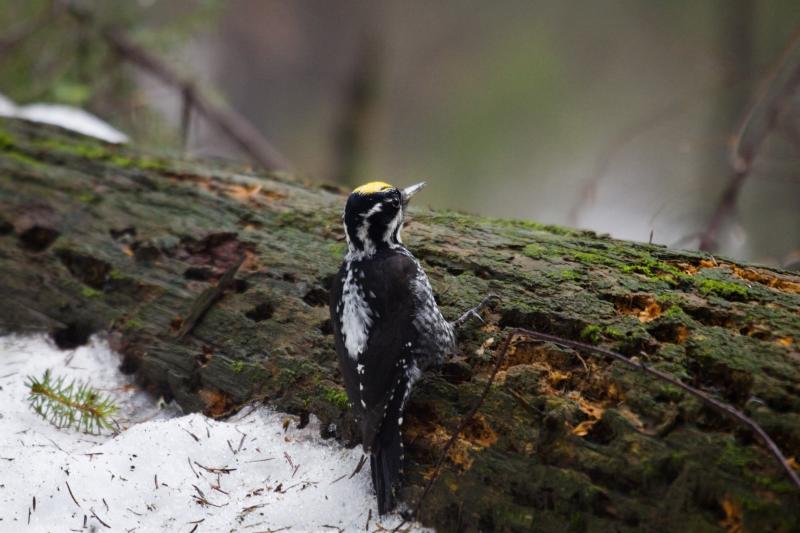
Männchen mit gut erkennbarem gelben Oberkopf. Von Alberto Chiarle - https://www.flickr.com/photos/alberto_chiarle/5373229161/, CC BY-SA 3.0, Link Quelle: WIKIPEDIA
Behavior: ![]() Der Borkenkäferspezialist bevorzugt ungepflegte Fichtenwälder mit reichlich Totholz. [Portrait]
Der Borkenkäferspezialist bevorzugt ungepflegte Fichtenwälder mit reichlich Totholz. [Portrait]
Verhalten: ![]() Die Anwesenheit des heimlichen Dreizehenspechts wird oft übersehen. Er ist wenig scheu und fliegt kaum weg, wenn man sich ihm nähert. [Portrait]
Die Anwesenheit des heimlichen Dreizehenspechts wird oft übersehen. Er ist wenig scheu und fliegt kaum weg, wenn man sich ihm nähert. [Portrait]
Gesang:
Fast drumming, constant volume, longer than great spotted woodpecker's.
Gesang Eigenschaften:
Melody: einfach rhythmisch, schnell, Frequency: low (1-3 KHz) Special sounds: trommeln
Ruf:
Behavior: ![]() Seine unauffälligen Rufe sind nicht laut und tönen ähnlich wie jene des Buntspechts. [Portrait]
Seine unauffälligen Rufe sind nicht laut und tönen ähnlich wie jene des Buntspechts. [Portrait]
♫ Quelle: XENOCANTO (Ruf)

Ruf Eigenschaften:
Trommeln Ruf Melodie: einfach rhythmisch, langsam, Frequenz: low (1-3 KHz),
Überordnung Galloanserae:
Ordnung Galliformes (Hühnervögel / Landfowls):
Familie Phasianidae (Turkeys):
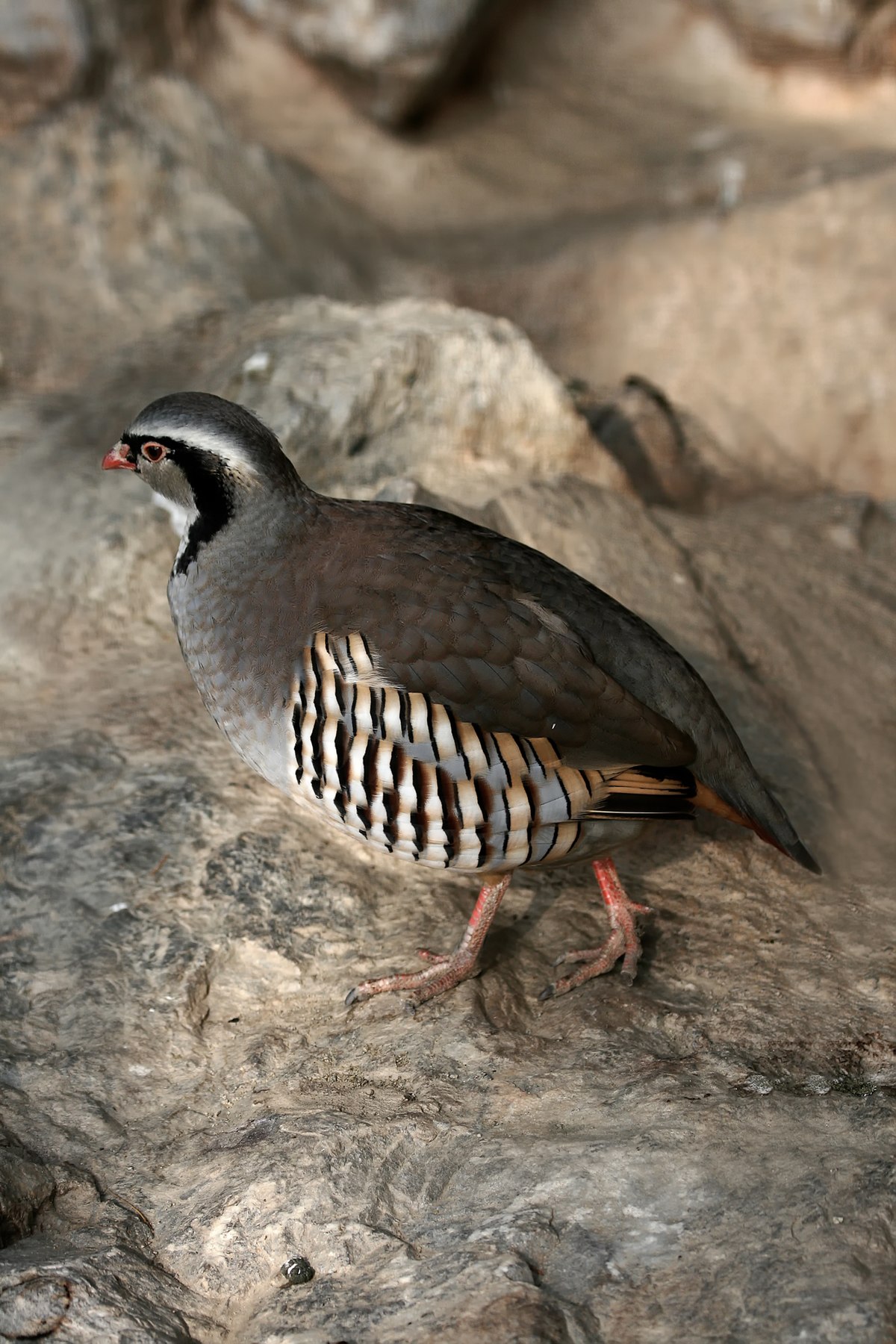
Wikipedia: Rock partridge
Allgemein: ![]() Das Steinhuhn (Alectoris graeca) ist eine Vogelart aus der Familie der Fasanenartigen (Phasianidae), die zur Ordnung der Hühnervögel (Galliformes) gehört. Es ist ein scheuer Bodenvogel, der geschickt und ausdauernd läuft und das gesamte Jahr über an steinigen, grasbewachsenen sonnigen Berghängen zu beobachten ist (meidet Nordlagen)[1]. Während des Winterhalbjahrs hält er sich in tieferen Lagen auf.
[more]
Das Steinhuhn (Alectoris graeca) ist eine Vogelart aus der Familie der Fasanenartigen (Phasianidae), die zur Ordnung der Hühnervögel (Galliformes) gehört. Es ist ein scheuer Bodenvogel, der geschickt und ausdauernd läuft und das gesamte Jahr über an steinigen, grasbewachsenen sonnigen Berghängen zu beobachten ist (meidet Nordlagen)[1]. Während des Winterhalbjahrs hält er sich in tieferen Lagen auf.
[more]